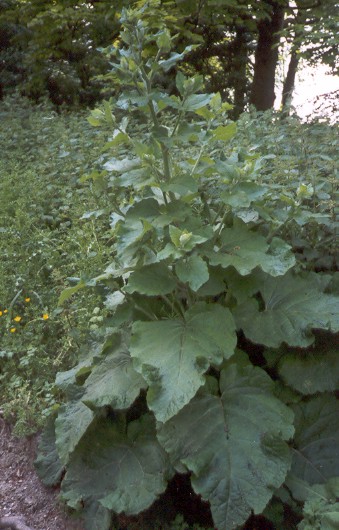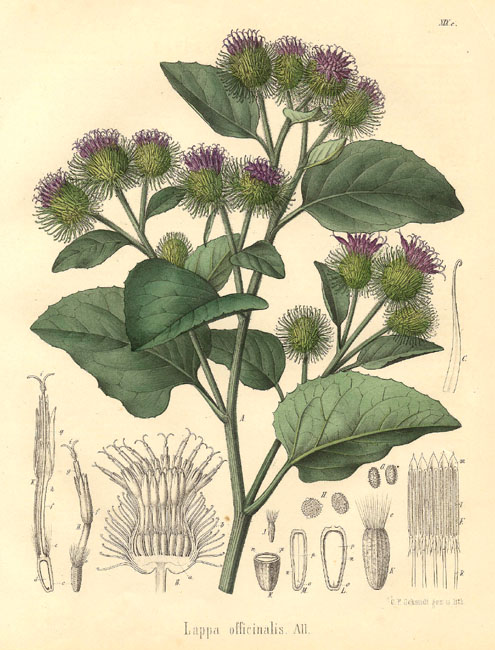
Arctium lappa (L)
Synonyms: Arctium majus (Bernh.), Bardanae radix, Bardanae folium, bardana, great burdock, hardock, hareburr, hurrburr, turkey burrseed, great bur, cocklebur, beggars buttons, cockle buttons, lappa, bardane, thorny burr, fox's clote, love leaves, personata, clotbur, happy major.
Order: Compositae

Description: Arctium is a substantial biennial plant reaching up to 2m in height, with very large ovate-cordate leaves up to 50cm across forming a rosette at ground level, with smaller versions growing up the thick flowering stem. The plant flowers in June and July and the flowers are borne in clusters at the top of the stem; they are globular in shape and covered with a dense array of stiff hooked bracts that cling to clothes on contact. The long roots grow straight down as much as 1m into the subsoil. There are several similar species of burdock and it is often difficult to distinguish one from the other. It grows on roadsides and waste places and around field boundaries throughout Britain, Europe and North America; it is cultivated in Japan.
Parts used: roots and rhizome, leaves, seeds
Collection: The roots and rhizome should be unearthed in September or October of the first year, or in the following spring when the flowers appear. The leaves should be harvested before or during early flowering, and the seeds when ripe in late summer.
Constituents: Root: up to 50% inulin, polyacetylenes, volatile acids (acetic, proprionic, butyric, isovaleric), non-hydroxyl acids (lauric, myristic, stearic, palmitic), tannin, polyphenolic acids. Seeds:15-30% fixed oils, a bitter glycoside (arctiin), chlorogenic acid and vitamins A and B2. Leaves: contain flavonoids and antibacterial substances, arctiol, fukinone and taraxasterol.
Actions: Leaves: mild laxative, mild diuretic, depurative. Root: Depurative, mild laxative, mild diuretic, bitter, diaphoretic, antirheumatic, antibiotic, orexigenic. Seeds: prevent fever, anti-inflammatory, antibacterial, reduce blood sugar levels, relaxant, demulcent, tonic.
Indications: The herb is specifically indicated as a poultice for boils and abscesses, the root for psoriasis and the dry and desquamatory phase of eczema.
Therapeutics and Pharmacology: Arctium is a valuable remedy for the treatment of dry and scaly skin conditions such as psoriasis and eczema. It cleanses the blood, and should be used gently over a period of time. It may be used as part of a wider treatment for rheumatic complaints, especially where there is associated with psoriasis. An infusion of the leaf may be applied to cracks, grazes, chapped skin and insect bites. Arctium has an antimicrobial action which has been attributed to the polyacetylenes in the plant. This explains its reputation for treating toxic conditions resulting in skin eruptions such as boils; it is also useful in treating acne. An extract of burdock root called burdock root oil is used to stimulate hair growth in alopoecia.
 Part of the action Arctium is through bitter stimulation of the digestive juices and
bile secretion and it will thus aid digestion and stimulate the appetite. It has been used in anorexia nervosa and similar
conditions. It can also aid kidney function. Its
antimicrobial property, together with its diuretic action makes it useful for
treating cystitis. Both the roots and leaves can be used to treat
rheumatism and gout because they encourage the elimination of uric acid via the
kidneys.
Part of the action Arctium is through bitter stimulation of the digestive juices and
bile secretion and it will thus aid digestion and stimulate the appetite. It has been used in anorexia nervosa and similar
conditions. It can also aid kidney function. Its
antimicrobial property, together with its diuretic action makes it useful for
treating cystitis. Both the roots and leaves can be used to treat
rheumatism and gout because they encourage the elimination of uric acid via the
kidneys.
Externally it may be used as a compress or poultice to speed up the healing of wounds and ulcers. Eczema and psoriasis may also be treated in this way, although it is important to address the underlying imbalance at the same time.
Combinations: For skin problems, Arctium may be combined with Rumex, Trifolium or Galium.
Caution: Excessive use may precipitate a symptomatic crisis in severely toxic conditions or where eliminatory channels are deficient. Dosage should be cautious initially and gradually increased..
Preparation and Dosage: (thrice daily)
Regulatory status GSL
Dried root: 2-6g or by infusion
Liquid Extract: 1:1 in 25% alcohol, 2-8ml
Tincture: 1:10 in 45% alcohol, 8-12ml
Decoction: 1:20, 500ml per day
Additional Comments: Burdock is familiar for its hooked burrs; its botanical name is derived from the Greek arktos, or bear, suggesting rough-coated fruits, and lappa, to seize. The word lappa may also be derived from the Celtic llap, a hand, on account of its prehensile properties. The plant gets its name 'dock' from its large leaves, while the 'bur' is thought to be a contraction of the French bourre, from the Latin burra, a lock of wool. The Old English name for burdock was 'Herrif' from the Anglo-Saxon hoeg, a hedge, and reafe, a robber - or from the Anglo-Saxon verb reafian, to seize.
Culpeper wrote ' The burdock leaves are cooling and moderately drying, whereby good for old ulcers and sores.... The leaves applied to the places troubled with the shrinking in the sinews or arteries give much ease: a juice of the leaves or rather the roots themselves given to drink with old wine, doth wonderfully help the biting of any serpents; the root beaten with a little salt and laid on the place suddenly easeth the pain thereof, and helpeth those that are bit by a wild dog...
North American Eclectics valued the seeds for treating skin problems and as a diuretic. In China the seeds, niu bang zi, are used to dispel 'wind and heat evils', and to treat the eruptions of measles, sore throats, unproductive coughs, tonsillitis, colds and influenza. Research has shown that the seeds can lower blood sugar in rats. In France, the fresh root is used for lowering blood sugar, its inulin content making it particularly suitable for diabetics. In Asia, the root fibre has been shown to protect rats from the toxicity of various food colours.
Culinary uses include the Dandelion and Burdock drink, candied stalks, and the root can be used as a vegetable.
Bibliography
Bradley, P.R. (ed.) 1992 British Herbal Compendium, Volume 1, BHMA, Bournemouth.
BHMA 1983 British Herbal Pharmacopoeia, BHMA, Bournemouth.
Culpeper, N. 1649 Complete Herbal and English Physician, 1990 reprint of the 1814 London edition of Culpeper�s Complete Herbal, Meyer, Illinois.
Grieve, M. 1931 A Modern Herbal, (ed. C.F. Leyel 1985), London.
Hoffmann, D. 1990 The New Holistic Herbal, Second Edition, Element, Shaftesbury.
Lust, J. 1990 The Herb Book, Bantam, London.
Mabey, R. (ed.) 1991 The Complete New Herbal, Penguin, London.
Mills, S.Y. 1993 The A-Z of Modern Herbalism, Diamond Books, London.
Ody, P. 1993 The Herb Society's Complete Medicinal Herbal, Dorling Kindersley, London.
Weiss, R.F. 1991 Herbal Medicine, Beaconsfield Arcanum, Beaconsfield.










